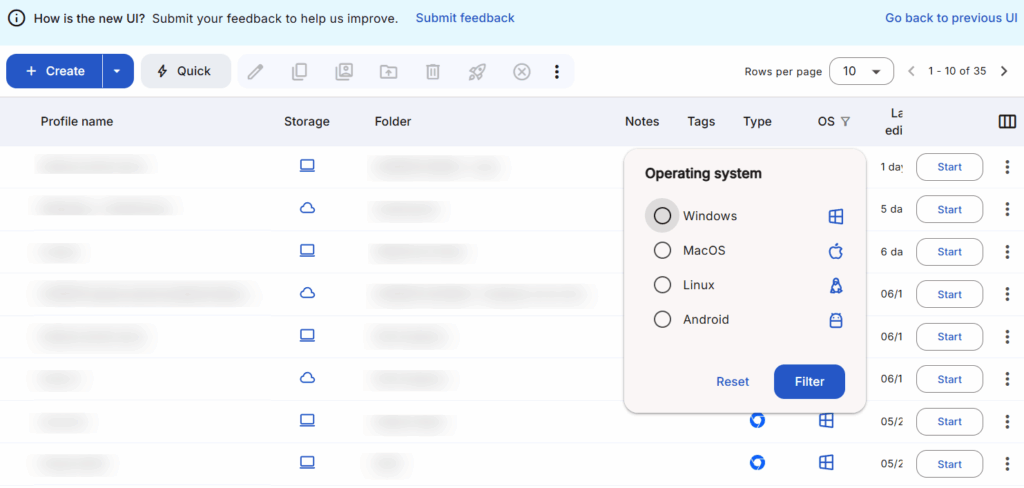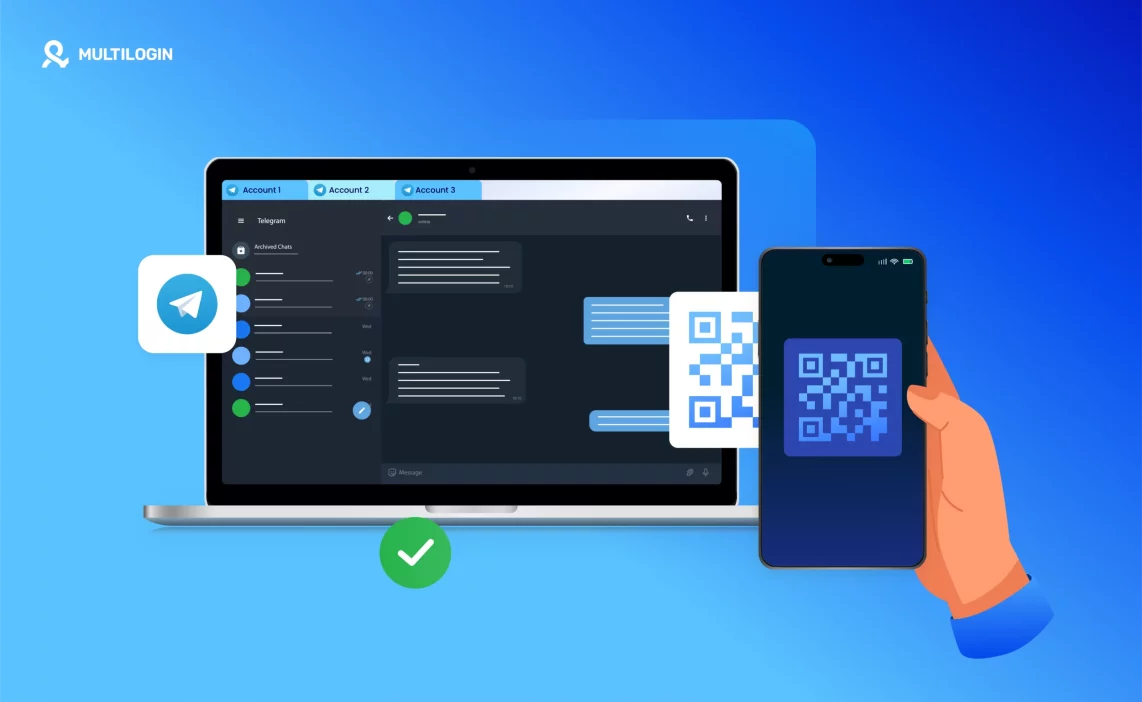Manage Multiple Telegram Accounts with Zero Overlaps
Need to check your Telegram messages on a different device—fast? Web Telegram makes that easy. No apps, no downloads. Just open your browser and log in.
In this article, you’ll find clear instructions on how to access Telegram in your browser, what you can and can’t do with Web Telegram, and how to manage multiple accounts without triggering restrictions.
What is Web Telegram?
Web Telegram lets you use your Telegram account right from your browser—no app, no download. Just scan a QR code or enter your number, and you’re in.
It works on any modern browser and gives you access to your chats, groups, and channels. Messages sync in real time with your phone, so you won’t miss anything. You can reply, forward, search messages, or manage files just like on the app.
Web Telegram is especially useful when you’re on a borrowed computer, switching devices, or need quick access without downloads.
Key Reasons to Use Telegram Web in 2025
Telegram Web gives you quick access to your chats without needing to install anything. It’s a good fit for people who work across multiple devices, travel often, or use shared computers. Whether you’re sending files, managing groups, or replying to messages on the go, it works straight from the browser.
- No downloads or installs: By using Telegram Web, you don’t need to download or install any application. You can easily log in through any of your browsers.
- Works on any device: You can use Telegram Web on any device that has a modern browser—Windows, macOS, Linux, or Chromebook. As long as you have internet, it works.
- Fast access to all chats: Once you log in, everything syncs instantly—your chats, contacts, and channels appear just like they do on your phone. You can continue conversations without interruption.
- Mobile phone not required after login: Telegram Web works even if your phone is offline. After the first login, the browser session becomes independent, which is great if your phone battery dies or you leave it behind.
- Voice calling in the browser: You can place voice calls straight from your browser.
- Ideal for managing multiple accounts: If you manage several Telegram accounts, Web Telegram makes it easier to switch between them using browser sessions, especially if you’re also using tools like Multilogin for managing multiple browser profiles.
- Clean layout, minimal distractions: The interface is stripped-down and functional. It’s good for focused messaging and quick replies, especially during work.
- Great for remote work or travel: You can log in from any hotel computer or co-working space and stay connected with your team or clients. Once you’re done, just log out—no files left behind.
How to Login to Web Telegram with a QR Code or Phone Number
You can sign in to Telegram Web in two simple ways: using your phone number or scanning a QR code. Both methods are quick and take less than a minute.
- Open web.telegram.org in your browser.
- You’ll see a large QR code on the screen.

- On your phone, open the Telegram app.
- Tap settings > devices > link desktop device.
- Scan the QR code shown on your computer screen.

If you don’t have access to your Telegram app right away or prefer not to use the QR code, you can log in using your phone number.
- Go to web.telegram.org in your browser.
- Click on “Log in by phone number.”

- Select your country and type in your phone number.

- Telegram will send a code to your mobile Telegram app.
- Enter that code on the web login screen to access your account.

How Does Telegram Web Work Once You’re Logged In?
Once you’re logged into Telegram Web, you’ll see a layout that feels natural if you’ve used the app before. On the left, you get a full list of your recent chats, channels, and groups. At the top, the search bar helps you find messages, contacts, or keywords instantly.
Everything loads right in your browser; no lag, no setup.
Here’s what you can do in Telegram Web:
- Send and receive messages in real-time
- View and reply to group chats and channels
- Use stickers, emojis, and voice notes
- Upload files and photos
- Access pinned messages and shared media
- Search your entire chat history

What Can You Do with Telegram Web — and What’s Missing?
Supported on Telegram Web | Not Supported on Telegram Web |
Regular chats, groups, and channels | Secret Chats |
File sharing (images, videos, documents) | Full support for voice or video calling |
Voice messages | Managing advanced privacy or security settings |
Stickers, emoji, and message reactions | Access to local files, contacts, or calendars |
Pinned messages and chat search | Certain device-specific permissions and media access |
Desktop notifications (with permission granted) | Some notification features (e.g., persistent banner alerts) |
Telegram Web vs Desktop Comparison
Telegram Web is fantastic for getting to Telegram quickly from any browser without having to install anything. Telegram Desktop, on the other hand, has more complex capabilities like secret chats, video calls, and support for multiple accounts. Desktop is the preferable choice if you require all the features and want to use it for a long time. Web is quick for sending messages on the go.
Feature | Telegram Web | Telegram Desktop |
Text Chat | ✅ | ✅ |
Send Files & Media | ✅ | ✅ |
Stickers & Emojis | ✅ | ✅ |
Voice/Video Call | ❌ | ✅ |
Run Multiple Accounts | ❌ | ✅ (up to 3) |
Dark Theme Support | ✅ | ✅ |
Auto-Delete Messages | ❌ | ✅ |
Export Chat Logs | ❌ | ✅ |
Works Without App | ❌ | ✅ |
Custom Themes | ❌ | ✅ |
Block Users | ✅ | ✅ |
How to Manage Multiple Telegram Accounts in One Browser
If you’ve ever tried using more than one Telegram Web account in the same browser, you know it doesn’t really work. Opening another tab or even switching profiles usually logs you out of the first one.
Multilogin, the first and leading anti-detect browser, solves this. It lets you open fully isolated browser profiles that don’t interfere with each other. Each profile runs with its own login, cookies, and settings; so you can use multiple Telegram Web accounts at once without one logging the other out. No more workarounds, just smooth multitasking.
Get Started
- Create an account at Multilogin.com, then select a plan that fits the number of browser profiles you want.

- Install the Multilogin X desktop app on Windows, macOS, or Linux—built for multi‑account and anti‑detect use.

- Create Browser Profiles

- Go to your dashboard and create a new profile for each Telegram account.
- Add a unique user agent, screen size, OS, etc.
- Assign a separate proxy to each profile.
- You now have a real, isolated identity for each account.
Manage and Organize Profiles:

- Sort profiles into groups to stay organized.
- If you work with a team, add teammates and assign access permissions by profile.
Launch Telegram Accounts:

- Launch a profile from the dashboard.
- Open Telegram Web in the browser.
- Log in using QR code or phone number. Each profile remembers its session.
Use Automation if Needed:
- Multilogin supports automation tools like Puppeteer, Selenium, and Playwright.
- You can also use the Multilogin API to control profiles at scale, useful for streamlining workflows.
To stay undetected long-term, make sure each Telegram Web account uses a different email address and phone number. Avoid reusing any billing or shipping information across accounts, as overlapping details can raise red flags. Also, allow each Multilogin browser profile to collect cookies over time—this helps simulate natural browsing behavior and builds a more believable identity in the eyes of detection systems.
Tip:
Before logging in to Telegram Web, it’s smart to verify that your browser profile is properly configured. This helps you avoid detection issues or accidental overlaps across accounts. You can do this using Pixelscan—an independent browser fingerprinting checker.
- Launch your newly created profile in Multilogin.
- Visit https://pixelscan.net and click the “Start” button.
- Review the fingerprint report.
Why Multilogin Stands Out for Telegram Web Users?
If you’re juggling multiple Telegram accounts or managing workflows across teams, you need more than just a browser—you need a purpose-built solution that works with you, not against you. That’s where Multilogin comes in.
Multilogin isn’t just another browser. It’s a full platform built for account management at scale. With smart fingerprint controls, flexible proxy options, and built-in automation tools, it gives you the control you need without the hassle.
Here’s why Multilogin works so well for Telegram Web:
- Built-in proxy tools: Skip the manual setup. Multilogin lets you use your own proxies or pick from millions of real IPs across the globe. Each profile can run on a different connection to keep sessions isolated and stable.
- Real browser fingerprint control: Every browser profile has a unique setup—OS, language, device type, resolution, and more. These details are matched with the proxy to avoid red flags and login issues on platforms like Telegram.
- Chromium and firefox engines: Switch between the Chromium-based Mimic and Firefox-based Stealthfox to run your sessions in an environment that fits your task, whether you’re after speed, stability, or stealth.
- Automation without the coding: Multilogin supports Puppeteer, Selenium, and Playwright, but you can also use built-in Quick Actions to launch sessions, group profiles, and set proxies—all without writing a single line of code.
- Made for teams: You can share access with your team, assign roles, monitor usage, and recover deleted profiles. Profiles sync in the cloud, so you can work from anywhere with peace of mind.
- Security by design: Your data stays private. Multilogin is GDPR-compliant, keeps passwords hashed, and deletes profiles after 90 days if you don’t need them anymore.
Common Telegram Web Login Problems and How to Fix Them
Even though Telegram Web is fast and easy to use, you might still hit a few snags—especially when logging in or managing more than one account. Below are some of the most common issues users run into and what actually works to fix them.
Login Code Doesn’t Arrive
Tried logging in with your phone number but didn’t get the code?
Here’s what usually helps:
- Open the Telegram app on your phone—this often triggers the code to be delivered.
- Switch from Wi-Fi to mobile data.
- Avoid hitting “Resend” too many times—it can lead to a temporary lockout.
QR Code Won’t Scan
Can’t get your phone to read the QR code?
- Make sure your camera lens is clean and there’s enough light.
- Move the phone slowly and steadily.
- If it still doesn’t scan, refresh the page to generate a new code.
Messages Not Syncing Between Devices
You send a message on your browser, but it’s missing from your phone—or the other way around.
- Refresh your Telegram Web tab.
- Restart the Telegram app on your phone.
- Double-check that both devices are connected to the internet.
How to Avoid These Issues Long-Term
- Use separate browser profiles with Multilogin to keep each Telegram session stable and logged in.
- Clear your browser cache once in a while if things feel stuck.
- Keep your mobile app up to date—it plays a key role in login and syncing.
Telegram Web works well most of the time, but when it doesn’t, these fixes usually get you back on track fast. And if you’re managing more than one account, using a dedicated multi-login tool like Multilogin keeps everything clean, secure, and hassle-free.
Run Telegram Web Without Getting Logged Out
Conclusion
Telegram Web online gives you fast, reliable access to your messages—no downloads, no setup. Whether you’re working from a different device or juggling multiple tasks at once, Web Telegram works right in your browser with full sync across devices. It’s lightweight, simple, and perfect for everyday use when you don’t have access to your main phone or app. And for users managing multiple Telegram accounts, smart browser management makes all the difference.
FAQ
The fastest way to open Telegram Web online is to visit web.telegram.org, scan the QR code with your phone using the Telegram app, and you’ll be logged in instantly. There’s no need to install anything, and it works on any modern browser.
Yes, you can use Telegram Web on multiple devices at the same time. You can stay logged in on your browser while still using the Telegram mobile or desktop app. Just avoid opening the same Telegram account in multiple browser tabs or windows, as that can lead to session conflicts or unexpected logouts.
To keep multiple Telegram Web accounts logged in at once, you’ll need to use a tool like Multilogin. It creates fully separate browser profiles, each with its own cookies, login sessions, and fingerprint. This prevents Telegram from detecting multiple logins and keeps each account running independently.
Using Telegram Web in public places or on shared devices is generally safe if you take a few precautions. Always remember to log out after use, avoid saving passwords in the browser, and if possible, use a private browsing window or an isolated session via Multilogin to keep your account data secure.
If the Telegram Web QR code doesn’t scan, try cleaning your camera lens and making sure the room is well-lit. Move your phone slowly toward the screen, and double-check that the Telegram app on your phone is open and ready to link. If it still doesn’t work, refresh the browser page to generate a new QR code.
Yes, Telegram Web online does support desktop notifications. Once you grant permission in your browser, you can receive alerts for new messages even when Telegram isn’t the active tab. This helps you stay updated without constantly switching windows.
The best way to manage 10 or more Telegram accounts for work is to use Multilogin. It lets you create individual, isolated browser profiles—each with its own proxy, fingerprint, and session data. This setup prevents account clashes and is especially useful for agencies, freelancers, or customer support teams juggling multiple identities.
Yes, Telegram Web does work with automation tools like Selenium, Puppeteer, and Playwright. When paired with a browser profile manager like Multilogin, automation becomes much more stable and undetectable, allowing you to control multiple sessions programmatically without triggering login issues.



